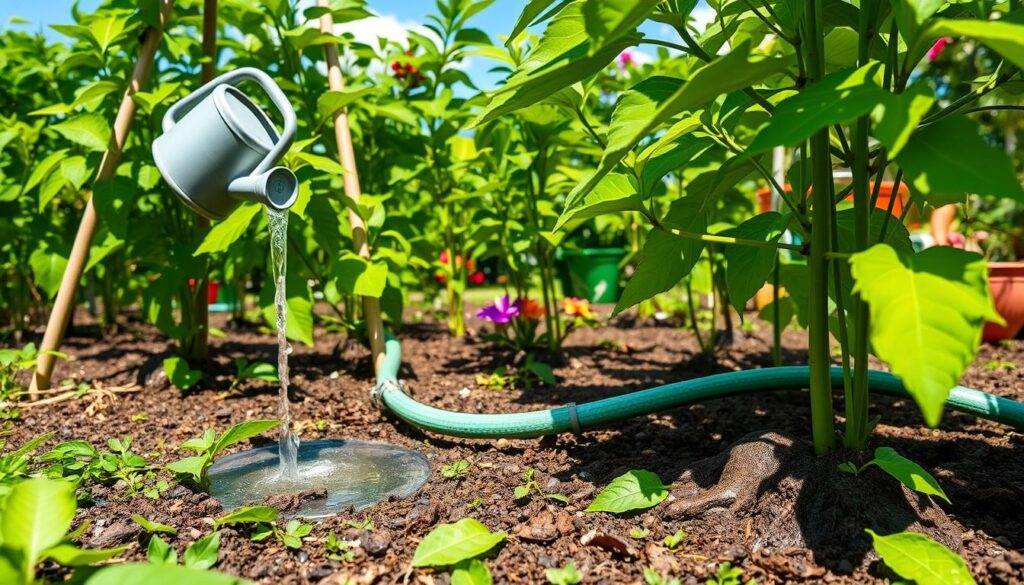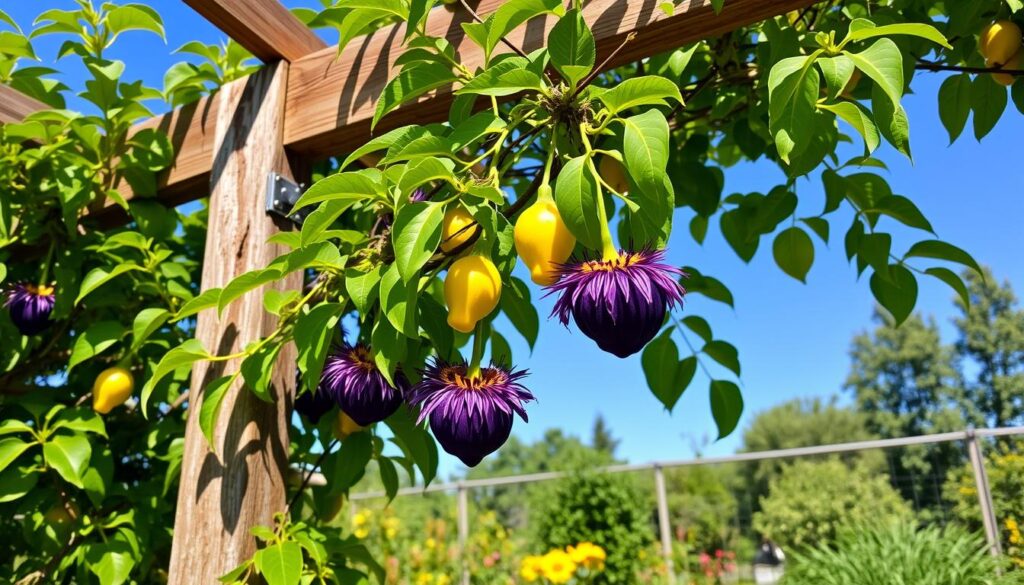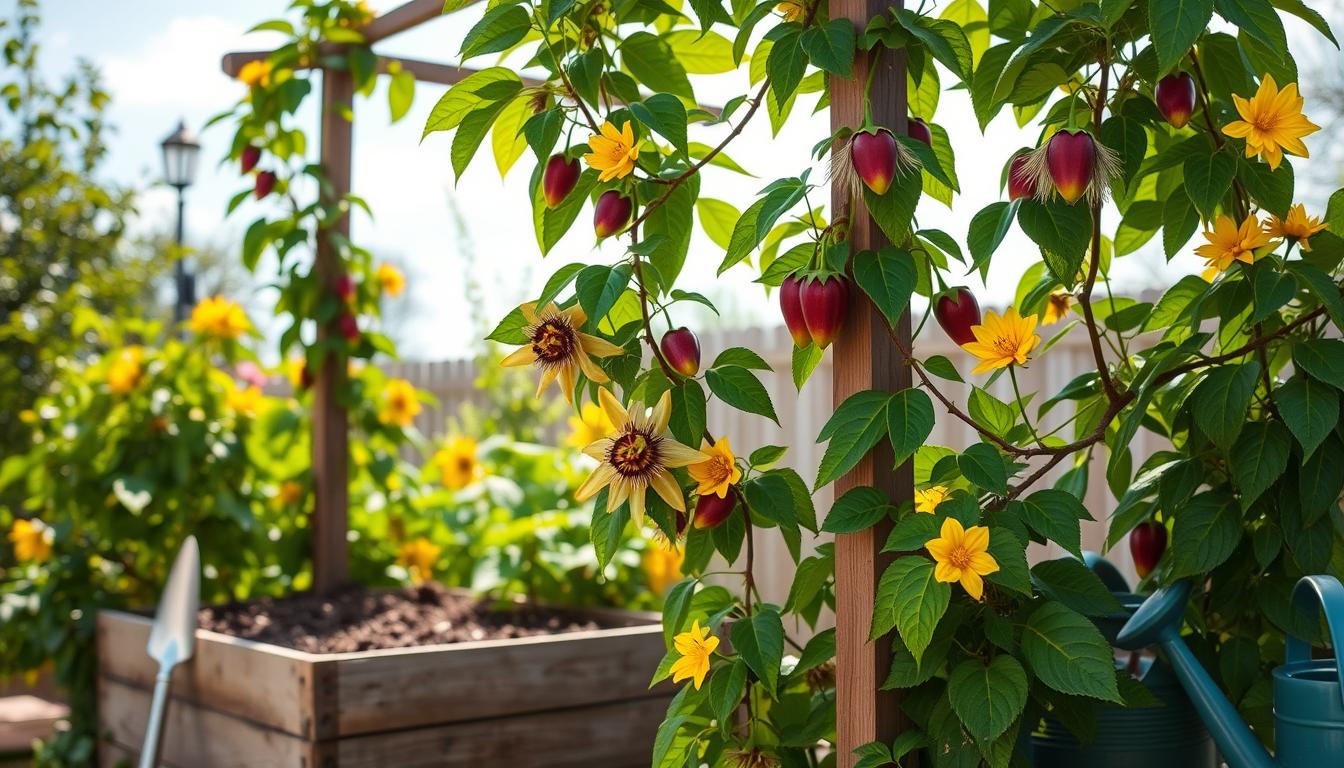Are you looking to make your garden more vibrant and your meals more delicious? Growing passion fruit vines at home is a great choice. These vines are not only beautiful but also produce tasty and healthy fruit. In this guide, I’ll share key tips on growing passion fruit vines at home. We’ll cover everything from choosing the right plant to enjoying your harvest.
With the right care, you can easily add this vibrant plant to your garden. It promises a fruitful and rewarding experience.
Key Takeaways
- Passion fruit vines can begin producing fruit in as little as 16 months under ideal conditions.
- Most passion fruit vines can thrive for about 7 years, with peak productivity in the first few years.
- They are versatile and can grow in various climates, but cooler regions may require protective greenhouses.
- Regular pruning in the colder months helps maintain vine health and productivity.
- Signs of ripeness include a change in color and a slight give when pressed.
- Proper care includes weekly watering during spring and summer to ensure robust growth.
- Consider hand-pollinating flowers if adverse weather is expected during the flowering season.
Introduction to Passion Fruit Vines
Passion fruit vines (Passiflora edulis) are amazing plants known for their beautiful fruit and flowers. They grow fast, reaching 10 to 20 feet tall in a year. Knowing their basic needs is key for growing them indoors or outdoors.
These vines love warm weather, doing best in Zones 10-12 with mild winters. Even in cooler areas, you can grow them indoors. They need at least six hours of sun a day but must avoid too much heat and wind.
For passion fruit vine care, they need well-draining soil with a pH of 5.5 to 6.5. They also need strong support for their thick trunks. Passion fruit vines live for five to seven years, bringing joy all year.
There are over 50 types of passion fruit, like purple and yellow varieties. Purple ones have a strong flavor, while yellow ones are more acidic. Knowing this helps choose the right one for your garden or indoor space.
Regular care is crucial, like deep watering and fertilizing four times a year. If you’re new to gardening, sites like GardenBeginner.com offer great help. They provide clear guides and tips for a successful gardening journey.
The Origin and Meaning of Passion Fruit
The story of passion fruit is as rich as its flavor. The term *passion* doesn’t mean what you might think. It actually comes from the *passion of Christ*. Early Spanish missionaries saw the flowers’ unique features and linked them to Christ’s crucifixion.
This background of passion fruit goes beyond just a name. It shows a deep connection to spirituality and history.
Passion fruit is from South America and has become popular worldwide. It’s known for its vibrant taste and health benefits. The fruit is full of vitamins A and C, making it a favorite among health fans.
The leaves of passion fruit are also special. They have calming effects, which has increased demand for the fruit and its leaves.
Brazil is the biggest producer of passion fruit, followed by Colombia and Peru. There are over 500 species in the Passiflora genus. But only a few are edible.
As I explore passion fruit, I see a chance for people to grow their own vines. This taps into centuries of innovation and spiritual meaning.
How to Grow Passion Fruit Vines at Home
Growing passion fruit vines at home is rewarding. It requires a few key steps for your plants to thrive. Start by choosing varieties that fit your climate. I like the Nellie Kelly for its cool weather tolerance and pest resistance.
Choosing the Right Variety for Home Cultivation
When picking passion fruit varieties, think about your climate and space. The Nellie Kelly is a favorite for its adaptability. Other good choices include Banana, Panama Gold, and Norfolk Island. These vines need a lot of room and a strong trellis for support.
Preparing Your Space for Planting
Preparing your space for planting is crucial. Make sure your area gets 6-8 hours of sunlight daily. The soil should be well-drained and rich, with a pH of 5.5 to 6.5. Keep it weed-free to help your vines grow better. Remember, watering regularly is key, especially when they’re fruiting.
If you want more tips, check out this resource. It has great advice on growing passion fruits.
Passion Fruit Vine Care
Caring for passion fruit vines is key to their health and fruit production. Proper watering and fertilizing are crucial. Good soil quality and drainage are also vital for these vines to thrive.
Watering and Fertilizing Techniques
In warm months, water your passion fruit vines deeply once a week. This is especially important when they’re young or when fruit is growing. Inconsistent watering can cause fruit to drop and slow growth.
Use a balanced organic fertilizer rich in potassium to boost flowering and fruit. Avoid fertilizers high in nitrogen, as they can make leaves grow but reduce fruit. Choose a fertilizer for flowering plants with a pH of 6.1 to 7.5.
Importance of Soil Quality and Drainage
Soil quality is crucial for passion fruit vines. Add compost to improve soil structure and nutrients. Passion fruit vines need soil that drains well to avoid root rot.
Planting in raised beds or sloped areas helps with drainage. This keeps moisture away from the roots, keeping them healthy and strong.

Backyard Passion Fruit Growing Strategies
When growing passion fruit in your backyard, using the right gardening strategies is key. Use strong trellises or fences to help the vines climb. This keeps them upright and lets air move around the plants. Make sure to pick a spot for your passion fruit vines where they won’t block other plants.
Training the vines to climb saves space and makes picking fruit easier. It’s important to water them right, aiming for about 1 inch of water each week. Check the soil often to make sure they get enough water.
Knowing the best growing conditions is also crucial. Passion plants like soil with a pH of 3.5 to 5.5 and do well in zones 9 to 11. Give each plant 6 to 10 feet of space to grow and to make maintenance easier.
| Variety | Weight (ounces) | First Fruit Production Timeline |
|---|---|---|
| Purple Passion | 1.4 | 12-18 months |
| Yellow Passion | 2.8 | 12-18 months |
| Sweet Granadilla | 3.5 | 12-18 months |
| Giant Granadilla | 144 (9 lbs) | 12-18 months |
In conclusion, using good strategies for growing passion fruit can lead to a great harvest. Watch out for pests like mealybugs and aphids to keep your garden healthy. With the right care, your passion fruit vine will thrive, giving you a rewarding gardening experience.
Understanding Passion Fruit Vine Maintenance
Keeping passion fruit vines healthy means knowing how to prune and manage weeds and pests. These steps help the vines grow strong and produce lots of fruit.
Pruning Techniques for Healthier Vines
Pruning is key to keeping passion fruit vines in top shape. I prune in early spring to cut out dead or weak parts. This helps the vines grow better and prevents diseases.
By carefully thinning the vines, I’ve seen them become healthier and more productive. This leads to beautiful leaves and a big harvest later on.
Managing Weeds and Pest Control
It’s important to keep weeds under control to make sure vines get enough nutrients and water. I use organic mulch to stop weeds and keep the soil moist.
For pests like aphids, I watch the vines closely and act fast to stop problems. This keeps the vines and fruit safe. Taking care of weeds and pests makes the vines and garden healthier and more fruitful.
Knowing how to care for passion fruit vines helps them thrive. For more on affiliate disclosures and potential income from product purchases, check out this link.
| Practice | Details |
|---|---|
| Pruning | Remove dead or weak growth in early spring to promote air circulation. |
| Weed Management | Use organic mulch to suppress weeds and retain moisture. |
| Pest Control | Monitor for aphids and treat promptly to safeguard vine health. |
Indoor Passion Fruit Cultivation Tips
Growing passion fruit indoors can add a tropical touch to your home. Success depends on the right light, container, and soil. These elements are key to growing passion fruit well indoors.
Optimal Light Conditions for Growing Indoors
Passionflower vines love full sun, needing at least six hours of sunlight a day. A south-facing window is perfect for this. If sunlight is scarce, grow lights can help.
Use grow lights for 8 to 10 hours a day. This boosts growth and fruiting.
Container Selection and Soil Choices
Choosing the right container is important for passion fruit. I choose large containers for their root systems. Make sure the pot has good drainage holes.
For soil, a mix that drains well and has organic compost is best. It helps the plant grow without getting root rot from too much water.
For more tips, check out growing passion fruit indoors resources. They can help improve your indoor gardening skills.
Passion Fruit Trellis Setup
A sturdy trellis is key for passion fruit vines to grow well in your garden. The right trellis design is important. It helps the vines grow up and produce fruit.
Best Practices for Supporting Your Vines
Use strong materials like concrete mesh or treated wood for your trellis setup. The posts should be 1.5 meters tall and 45-75 cm deep in the soil. This lets the vines climb well, making it easier to care for them and pick the fruit.
Horizontal trellises with wire every 60 cm help the vines grow sideways. This is good for their health.
- Place the trellis in full sunlight.
- Plant the vines 3-4.5 meters apart for best growth.
- Check the trellis often for damage and fix it to withstand wind and weather.
Creating a Stable Environment for Growth
To help vines grow well, keep them pruned and trained. Well-cared-for vines can reach 2 meters tall and spread 6 meters. Prune them in late winter to keep them healthy and encourage more fruit.
Also, use rich soil with compost and mulch. This gives the plants the nutrients they need without too much manure.

For more tips on growing passion fruits, see this guide on garden beginner setups.
Seasonal Considerations for Passion Fruit Growth
Understanding the needs of passion fruit vines for seasonal growth is key to a bountiful harvest. The climate in your area greatly affects how your vines grow. Recognizing these seasonal changes helps keep your vines healthy and thriving.
How to Manage Growth in Different Climates
Passion fruit plants grow differently in various climates. In warm areas, they grow all year. But in cooler climates, they need protection from cold snaps. Using greenhouses or pots helps in these areas, offering both mobility and protection.
Strategies for Overcoming Environmental Challenges
When planting passion fruit, you might face environmental hurdles. Heavy rain, especially when they’re blooming, can be a challenge. Hand-pollinating the flowers helps ensure fruit set, even in tough weather. Also, using protective coverings during harsh weather is crucial for your vines’ health.
| Climate Zone | Growth Pattern | Management Strategy |
|---|---|---|
| Tropical | Continuous growth and blooming | Regular watering and fertilization |
| Temperate | Possible freezing during winter | Use of greenhouses or pots |
| Cooler Regions | Limited growth in colder months | Winter protection and frost covers |
Harvesting and Enjoying Your Passion Fruits
Timing is key when harvesting passion fruit. Look for a bright yellow color or when the fruit falls off the vine. A wrinkled skin and softness to the touch mean it’s ready. This ensures the fruit tastes its best.
Signs of Ripeness to Look For
Here are the signs I check for:
- Color change: Ripe passion fruit turns a vibrant yellow.
- Texture: A wrinkled, soft skin means it’s ready.
- Dropping: If it falls off the vine, it’s ripe.
Storage and Use of Passion Fruit
Storing passion fruit right keeps it fresh longer. I keep them cool and dry or refrigerate them. Freezing the pulp is also good for later use in smoothies or desserts. Passion fruit is versatile:
- Making refreshing juices.
- Adding to salads for a tropical flair.
- Using in desserts like mousse or ice cream.
- Incorporating into cocktails for a unique twist.
- Crafting homemade soap with aromatic properties.
| Ripeness Indicators | Storage Tips | Uses for Passion Fruit |
|---|---|---|
| Wrinkled skin | Refrigerate for extended freshness | Juices |
| Vivid yellow color | Store in cool, dry place | Mousse and desserts |
| Fruit drops from vine | Freeze pulp for later use | Salad dressings |
| Softness to pressure | Check for any signs of spoilage regularly | Cocktails |
Troubleshooting Common Issues with Passion Fruit Vines
Passion fruit vines face many challenges, like diseases and pests. These problems can harm their growth and fruit production. It’s important to spot these issues early and take action to keep your vine healthy.
Identifying and Treating Diseases
Look out for yellow leaves or wilting vines. These signs can mean root rot or viral infections. Treating diseases quickly is key. If you see these symptoms, here’s what to do:
- Remove and throw away infected plants to stop disease spread.
- Choose disease-resistant varieties to lower future risks.
- Test the soil to find out if it lacks nutrients or has too much.
Some common diseases to watch for are:
| Disease | Causes | Symptoms | Treatment |
|---|---|---|---|
| Fusarium Wilt | Fusarium oxysporum | Wilting and plant death | Remove infected plants, avoid overhead watering |
| Collar Rot | Haematonectria haematococca, Fusarium solani | Wilting, defoliation | Improve drainage, apply fungicides |
| Root and Crown Rot | Phytophthora species | Chlorosis, wilting | Improve soil drainage and reduce watering |
Solutions for Pest Infestations
Pests like aphids and spider mites can harm passion fruit vines. Regular checks can catch problems early. For small infestations, you can:
- Use organic insecticidal soaps.
- Attract beneficial insects, like ladybugs.
- Try companion planting to keep pests away.
Conclusion
Growing passion fruit vines at home is rewarding and adds beauty to my garden. It also improves my cooking. Choosing the right variety and caring for them properly leads to a good harvest. This guide shows how important the right planting conditions are.
Passion fruit grows well with legume trees like wattles. These trees help the soil and support the vines. This makes my garden vibrant and healthy.
Passion fruit vines grow fast and start producing fruit in 12 to 18 months. Knowing how to deal with diseases and prune them is key. This keeps the vines healthy and productive.
By using the tips from this article, I can grow passion fruit vines successfully. This not only increases my yield but also brings me joy. The partnership between passion fruit and trees like wattles boosts growth and creates a thriving backyard ecosystem. I’m excited to enjoy the fruits of my labor.



Leave a Reply